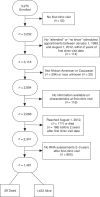African American race and HIV virological suppression: beyond disparities in clinic attendance
- PMID: 24812158
- PMCID: PMC4051874
- DOI: 10.1093/aje/kwu069
African American race and HIV virological suppression: beyond disparities in clinic attendance
Abstract
Racial disparities in clinic attendance may contribute to racial disparities in plasma human immunodeficiency virus type 1 : HIV-1) RNA levels among HIV-positive patients in care. Data from 946 African American and 535 Caucasian patients receiving HIV care at the University of North Carolina Center for AIDS Research HIV clinic between January 1, 1999, and August 1, 2012, were used to estimate the association between African American race and HIV virological suppression (i.e., undetectable HIV-1 RNA) when racial disparities in clinic attendance were lessened. Clinic attendance was measured as the proportion of scheduled clinic appointments attended (i.e., visit adherence) or the proportion of six 4-month intervals with at least 1 attended scheduled clinic appointment (i.e., visit constancy). In analyses accounting for patient characteristics, the risk ratio for achieving suppression when comparing African Americans with Caucasians was 0.91 (95% confidence interval: 0.85, 0.98). Lessening disparities in adherence or constancy lowered disparities in virological suppression by up to 44.4% and 11.1%, respectively. Interventions that lessen disparities in adherence may be more effective in eliminating disparities in suppression than interventions that lessen disparities in constancy. Given that gaps in care were limited to be no more than 2 years for both attendance measures, the impact of lessening disparities in adherence may be overstated.
Keywords: clinic visits; cohort studies; health status disparities; human immunodeficiency virus; viral load.
© The Author 2014. Published by Oxford University Press on behalf of the Johns Hopkins Bloomberg School of Public Health. All rights reserved. For permissions, please e-mail: journals.permissions@oup.com.
Figures


References
-
- Catz SL, McClure JB, Jones GN, et al. Predictors of outpatient medical appointment attendance among persons with HIV. AIDS Care. 1999;11(3):361–373. - PubMed
-
- Israelski D, Gore-Felton C, Power R, et al. Sociodemographic characteristics associated with medical appointment adherence among HIV-seropositive patients seeking treatment in a county outpatient facility. Prev Med. 2001;33(5):470–475. - PubMed
-
- Gulick RM, Ribaudo HJ, Shikuma CM, et al. Three- vs four-drug antiretroviral regimens for the initial treatment of HIV-1 infection: a randomized controlled trial. JAMA. 2006;296(7):769–781. - PubMed
Publication types
MeSH terms
Substances
Grants and funding
LinkOut - more resources
Full Text Sources
Other Literature Sources
Medical

